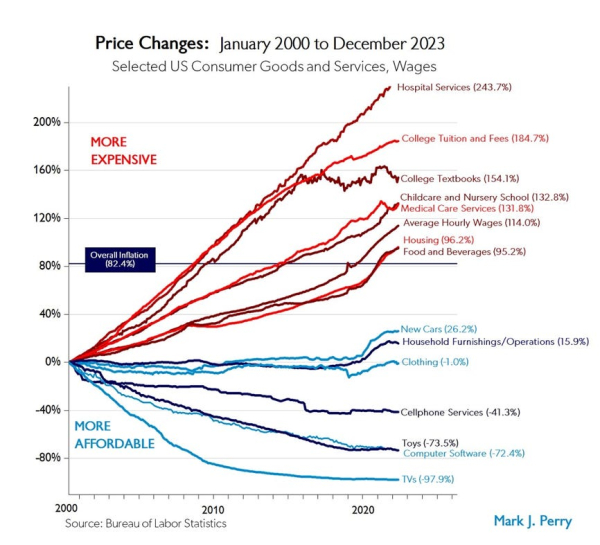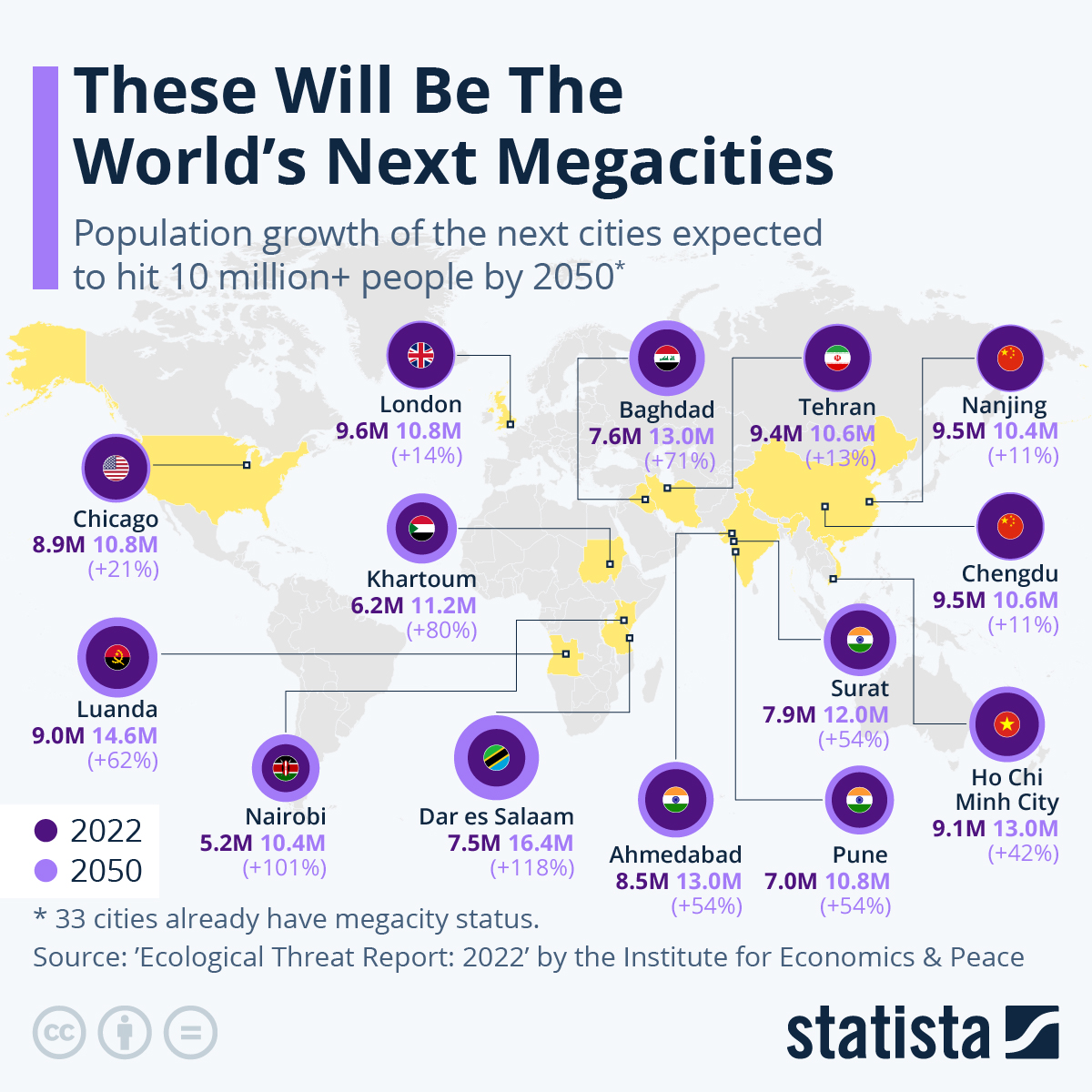This post considers the “Chart of the Century” created and named by Mark Perry, an economics professor and AEI scholar. This chart has received considerable attention because it contains extensive information about the challenges faced by the Fed and other Washington policymakers.
The most current version reports price increases from 1998 through the end of 2023 for 14 categories of goods and services, along with the average wage and overall Consumer Price Index.
It shows that prices of goods subject to foreign competition — think toys and television sets — have tumbled over the past two decades as trade barriers have come down worldwide. Meanwhile, the costs of so-called non-tradeable items — hospital stays and college tuition, to name two — have surged.
From January 1998 to now, the CPI for All Items has increased by over 90% (up from 59.6% in 2019, when I first shared this chart).
Lines above the overall inflation line have become functionally more expensive over time, and lines below the overall inflation line have become functionally less expensive.

via Human Progress
At the beginning of 2020 (when I shared the 2019 post), food, beverages, and housing were in line with inflation. They’ve now skyrocketed above inflation, which helps to explain the unease many households are feeling right now. College tuition and hospital services have also continued to rise over the past few years—even in relation to inflation.
There are many ways to interpret this chart. You can point to items in red whose prices have exceeded inflation as government-regulated or quasi-monopolies. You can point to items in blue as daily commodities that have suffered from ubiquity, are subject to free-market forces, or are goods subject to foreign competition and trade wars.
Looking at the prices that decrease the most, they’re all technologies. New technologies almost always become less expensive as we optimize manufacturing, components become cheaper, and competition increases. From VisualCapitalist, at the turn of the century, a flat-screen TV would cost around 17% of the median income ($42,148). In the early aughts, though, prices began to fall quickly. Today, a new TV will cost less than 1% of the U.S. median income ($54,132).
Compare “tradable” goods like cell phones or TVs (with lots of competing products) to less tradable “goods” like hospital stays or college tuition, and unsurprisingly, they’ve gone in opposite directions. In 2020, I asked what the Coronavirus would do to prices, and the answer was less than expected. If you don’t look at the rise in inflation but instead the change in trajectories, very few categories were heavily affected. While hospital services have skyrocketed since 2019, they were already skyrocketing.
At this point, we’re pretty far removed from quarantine’s most extreme forces. Textbooks have come back down, as have childcare and medical care services. New cars and household furnishings have leveled out. Otherwise, the trajectories have been pretty unaffected.
We can look one step deeper if we consider average hourly income. Since 2000, overall inflation has increased by 82.4%, while average hourly income has increased by 114%. This means that hourly income increased 38% faster than prices (which indicates a 14.8% decrease in overall time prices). You get 17.3% more today for the same amount of time worked ~24 years ago.
It’s interesting to look at data like that, knowing that the average household is feeling a “crunch” right now. My guess is that few consumers distinguish between perception and reality. However, feeling a crunch isn’t necessarily the same as being in a crunch.
For instance, we must account for ‘quality of life creep,’ where people tend to splurge on luxuries as their standard of living improves. With the ease of online shopping and access to consumer credit, it’s become increasingly easy to indulge in impulse purchases, leading to reduced savings and feelings of financial scarcity. This phenomenon is a function of increased consumption (rather than inflation), yet it still leaves consumers feeling like they’re struggling to make ends meet.
Perry’s ‘Chart of the Century’ reveals the complex relationships between inflation, consumption, and economic growth. While households may feel financial strain, the data shows that income has outpaced inflation, and technology has made many goods more affordable. Nonetheless, our tendency to splurge on luxuries and increased consumption have contributed to a sense of financial struggle.
How can policymakers address the sectors experiencing significant price hikes, like healthcare and education, without stifling innovation in tradable goods and services?
How do you think these issues will impact the Election?

Is Big Tech Faking AI?
Last week, I shared an article about Amazon's "Just Walk Out" technology – and how it likely required a team of human validators and data labelers.
My takeaway from the article was that we're right at the peak of inflated expectations and about to enter the trough of disillusionment.
Gartner via Wikipedia
One of my friends sent me this video, which he found in response.
via Sasha Yanshin
It's a pretty damning video from someone who is frustrated with AI - but it makes several interesting points. The presenter discusses Amazon's recent foible, Google's decreasing search quality, the increase of poorly written AI-crafted articles, GPTs web-scraping scandals, and the overall generalization of responses we see as everyone uses AI everywhere.
Yanshin attributes the disparity between the actual results and the excitement surrounding AI stocks to the substantial investments from technology giants. But as most bubbles prove, money will be the catalyst for amazing things — and some amazing failures and disappointments too.
His final takeaway is that, regardless of its current state, AI is coming and will undoubtedly improve our lives.
If I were to add some perspective from someone in the industry, it would be this.
AI Is Overdelivering in Countless Ways
There will always be a gap between expectations and reality (because there will always be a gap between the hype and adoption cycles). AI is already seamlessly integrated into your life. It's the underpinning of your Smartphones, Roombas, Alexas, Maps, etc. It has also massively improved supply chain management, data analytics, and more.
That's not what gets media coverage ... because it's not sexy ... even if it's real.
OverHype has existed for much longer than AI has been in the public eye. An easy example is the initial demo of the iPhone, which was almost totally faked,
Having created AI since arguably the mid-90s, the progress and capabilities of AI today are hard to believe. They're almost good enough to seem like science fiction.
The Tool Isn't Usually The Problem
Artificial Intelligence is not a substitute for the real thing—and it certainly can't compensate for the lack of the real thing.
I sound like a broken record, but AI is a tool, not a panacea. Misusing it, like using a shovel as a hammer, leads to disappointment. And it doesn't help if you're trying to hammer nails when you should be laying bricks.
ChatGPT is very impressive, as are many other generative AI tools. However, they're still products of the data used to train them. They won't make sure they give you factual information; they can only write their responses based on the data they have.
If you give an AI tool a general prompt, you'll likely get a general answer. Crafting precise prompts increases their utility and can create surprising results.
Even if AI independently achieves 80% of the desired outcome, it still did it without a human, a salary, or hours and days of time to create it.
Unfortunately, if you're asking the wrong questions, the answers still won't help you.
That's why it matters not only that you use the right tool but also that you use it to solve the right problem. In addition, many businesses lose sight of the issues they're solving because they get distracted by bright and shiny new opportunities.
Conclusion
Sifting the wheat from the chaff has become more complicated — and not just in AI. Figuring out what news is real, who to trust, and what companies won't misuse your data seems like it has almost become a full-time job.
If you take the time, you will see a lot of exciting progress.
What's the most exciting technology you've seen recently?
Posted at 08:16 PM in Business, Current Affairs, Gadgets, Ideas, Market Commentary, Personal Development, Science, Trading, Trading Tools, Web/Tech | Permalink | Comments (0)
Reblog (0)